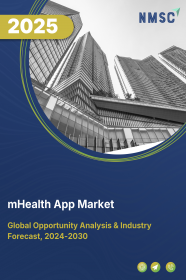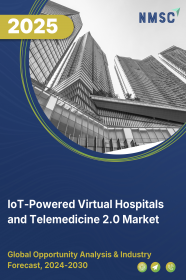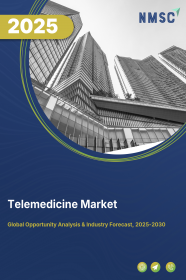
mHealth App Market by Product(Wellness and Lifestyle Management, Chronic Disease Management, Mental Health and Behavioral Apps, Others), by Application(Monitoring Services, Diagnostic Services, Treatment Services, Others), by Marketplace(Google Play Store, Apple App Store, Others), by End-User(Physicians, Patients, Insurance Companies, Government and Public Health Organizations, Hospitals & Clinics, and Others)- Global Opportunity Analysis and Industry Forecast 2024-2030
US Tariff Impact on mHealth App Market
Trump Tariffs Are Reshaping Global Business
Market Definition
The mHealth App Market size was valued at USD 64.02 billion in 2023 and is predicted to reach USD 428.29 billion by 2030 with a CAGR of 31.7% from 2024-2030. mHealth is an abbreviation used for the term mobile health. It refers to monitoring and sharing of health information via mobile technology. mhealth app can be used in various devices such as smart phones, tablet computers, personal digital assistants (PDAs) and wearable devices such as smart bands and smart watches. mHealth app is used for disease surveillance, treatment support, epidemic outbreak tracking and clinical health data collection as it can monitor a patient’s health in real-time allowing healthcare professionals to make efficient and accurate diagnoses.
Market Dynamics and Trends
The mHealth app market is experiencing robust growth driven the growing awareness of health and fitness worldwide, leading to an increased demand for mHealth apps among consumers. This trend is further facilitated by widespread access to high-speed internet, allowing users to easily download and use these applications.
Also, tech companies have played a significant role in commercializing medical health applications, making them more accessible and appealing to a wider audience. This has resulted in a surge in adoption rates, fueling market expansion. Additionally, healthcare providers are recognizing the potential of mHealth technology to revolutionize healthcare delivery. By leveraging mHealth apps, providers can streamline processes, improve patient engagement, and ultimately achieve cost savings compared to traditional methods. As a result, the adoption of mHealth technology by healthcare providers is accelerating, contributing further to the growth of the market.
However, strict government regulations, lower regulatory approvals for mHealth app due to data security and privacy concerns associated with online health data as it is prone to cyberattacks are the factors restraining the market during the forecast period. On the contrary, the trend for smart wearable medical devices is expected to create ample growth opportunities for the market in the coming years. For instance, in 2021, apple alone sold around 46.1 million of apples wearable device called iWatch across the world.
Market Segmentations and Scope of the Study
The mHealth app market is segmented on the basis of product, application, market place, end user and geography. On the basis of product, the market is classified into disease & treatment management, wellness management and others. The disease & treatment management market is further sub-segmented into medication reminders, disease management and healthcare providers / payors. The wellness management market is further sub-segmented into fitness management, lifestyle and stress management, woman’s health and pregnancy management and diet and nutrition management. On the basis of application, the market is divided into monitoring services, diagnostic services, treatment services and others. On the basis of market place, the market classified into google play store, apple app store, and others. On the basis of end user, the market is classified into physicians, patients, insurance companies, research centers, biopharmaceutical companies, government, tech companies and others. Geographic breakdown and analysis of each of the aforesaid segments includes regions comprising of North America, Europe, Asia-Pacific, and RoW.
Geographical Analysis
North America holds the major share of mHealth app market and is expected to continue its dominance during the forecast period. This is attributed to the factors such as rise in geriatric population base in the region and sedentary lifestyle of working individuals due to hectic work schedules is increasing prevalence of chronic diseases such as hypertension and heart diseases. As per the Population Reference Bureau, the population of Americans aged 65 and above is anticipated to rise from 58 million in 2022 to 82 million by 2050, indicating a 47% increase. Additionally, the proportion of individuals aged 65 and older in the overall population is expected to climb from 17% to 23%.
Also, presence of major market players in the region such as Fitbit, Google and Apple that are adopting various strategies including product launches is further boost the market growth in this region. For instance, in June 2023, Apple launched updates to its Health app, integrating features such as tracking menstrual cycles, monitoring reproductive health metrics, and logging symptoms such as cramps and headaches. These additions cater to a broader range of health needs, positioning Apple to further penetrate the growing mHealth app market with comprehensive wellness solutions.
On the other hand, Asia Pacific is expected to show a steady rise in the mHealth app market due to the large population in the region and rapid growth in the usage of smartphones among them. As per GSMA, a global organization uniting the mobile ecosystem, Asia Pacific is projected to have more than 3 billion smartphone connections by 2030. This indicates a smartphone adoption rate of 94% for the region, surpassing the global average of 92%.
Also, government initiatives aimed at promoting mobile health applications are driving their adoption among healthcare professionals in the region, consequently fueling the growth of the mHealth app market. These initiatives often include policies, subsidies, and programs designed to encourage the integration of digital health solutions into healthcare systems, thereby improving patient care, reducing healthcare costs, and enhancing overall public health outcomes. As healthcare providers increasingly embrace these technologies due to government support and incentives, the demand for mHealth apps continues to rise, driving market expansion in the region.
Competitive Landscape
The mhealth app market comprises of various market players such as OSP, my mhealth Limited, Scopic Inc., OMRON Healthcare Co. Ltd., Omada Health Inc., Teladoc Health, Inc., mySugr, Abbott, Calm, Centura Health, Boston Scientific Corporation, Smart Respiratory Products Ltd., Versus Arthritis, Sleep Cycle, and Neybox Digital Ltd.. These market players are adopting various strategies such as product launches and collaboration to maintain their dominance in the global mHealth app market.
For instance, in November 2023, Abbott launched the FreeStyle LibreLink app, allowing users to measure glucose levels without the need for finger pricking. The app, compatible with iPhone and Android smartphones, provides a convenient and non-invasive method for diabetes management, reflecting advancements in mHealth technology aimed at improving patient experience and outcomes.
Moreover, in January 2022, Pfizer sponsored a locally developed mhealth app in South Africa called MyCancerGuide for fast-tracking the adoption of telehealth globally. This web-based app solution would facilitate the early detection of breast and cervical cancer and decrease the high cancer-related death rate in South Africa.
Key Benefits
-
The report provides quantitative analysis and estimations of the mHealth app market from 2024 to 2030, which assists in identifying the prevailing market opportunities.
-
The study comprises a deep dive analysis of the mHealth app market including the current and future trends to depict prevalent investment pockets in the market.
-
Information related to key drivers, restraints, and opportunities and their impact on the mHealth app market is provided in the report.
-
Competitive analysis of the players, along with their market share is provided in the report.
-
SWOT analysis and Porters Five Forces model is elaborated in the study.
-
Value chain analysis in the market study provides a clear picture of roles of stakeholders.
Key Market Segments
By Product
-
Wellness and Lifestyle Management
-
Fitness and Exercise Apps
-
Diet and Nutrition Apps
-
Sleep Tracking Apps
-
Meditation and Mindfulness Apps
-
Women’s Health Apps
-
Smoking Cessation and Substance Abuse Apps
-
-
Chronic Disease Management
-
Diabetes Management Apps
-
Heart Disease and Hypertension Apps
-
Asthma and Respiratory Apps
-
Arthritis and Pain Management Apps
-
-
Mental Health and Behavioral Apps
-
Stress and Anxiety Relief Apps
-
Depression Management Apps
-
Teletherapy Apps
-
-
Others
By Application
-
Monitoring Services
-
Diagnostic Services
-
Treatment Services
-
Others
By Marketplace
-
Google Play Store
-
Apple App Store
-
Others
By End-User
-
Physicians
-
Patients
-
Insurance Companies
-
Government and Public Health Organizations
-
Hospitals & Clinics
-
Others
By Region
-
North America
-
U.S
-
Canada
-
Mexico
-
-
Europe
-
UK
-
Germany
-
France
-
Italy
-
Spain
-
Denmark
-
Netherlands
-
Finland
-
Sweden
-
Norway
-
Russia
-
Rest of Europe
-
-
Asia-Pacific
-
China
-
Japan
-
India
-
South Korea
-
Australia
-
Indonesia
-
Singapore
-
Taiwan
-
Thailand
-
Rest of Asia-Pacific
-
-
RoW
-
Latin America
-
Middle East
-
Africa
-
Key Players:
-
OSP
-
my mhealth Limited
-
Scopic Inc.
-
OMRON Healthcare Co. Ltd.
-
Omada Health Inc.
-
Teladoc Health, Inc.
-
mySugr
-
Abbott
-
Calm
-
Centura Health
-
Boston Scientific Corporation
-
Smart Respiratory Products Ltd.
-
Versus Arthritis
-
Sleep Cycle
-
Neybox Digital Ltd.
REPORT SCOPE AND SEGMENTATION:
|
|
|
|
|
|
|
|
|
|
|
|
|
|
|
|
|
|
|
|
|
|
|
|
|
|
|
|

















 Speak to Our Analyst
Speak to Our Analyst





















